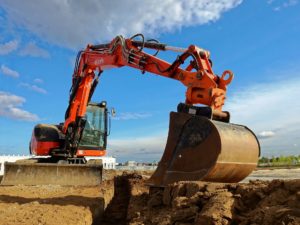excavation
The importance of safe digging
Richard Broome, MD at LSBUD, discusses why it’s so important that people adopt good safe digging practices to avoid hitting underground pipes and cables.
 Accidently hitting an underground pipe or cable during digging work can have significant and long-lasting effects on the person involved, and those around them. It’s therefore essential that the UK public and those involved in excavation work fully understand the implications that come with hitting gas, water, oil and chemical pipelines or electricity and broadband cables, and know how to prevent this from happening.
Accidently hitting an underground pipe or cable during digging work can have significant and long-lasting effects on the person involved, and those around them. It’s therefore essential that the UK public and those involved in excavation work fully understand the implications that come with hitting gas, water, oil and chemical pipelines or electricity and broadband cables, and know how to prevent this from happening.
The Consequences
Health & Safety
71% of all digging work that takes place in the UK is now preceded by a thorough search for pipes and cables through our portal. However, according to the Digging up Britain report, in 2019 alone there were 1,230 safety-related electrical incidents reported to the HSE, of which 73 were assigned as being injury-related. In addition, while the number of gas-related incidents has been in decline since 2013, there were still 1,248 reported in 2019.
There’s little doubt that the increased number of searches going through the LSBUD system have drastically helped to reduce the likelihood of such incidents occurring, but there is still room for improvement. People need to remember that by undertaking work with limited, or no prior knowledge of what is beneath them, there is a real risk of injury or even fatality.
Financial
Whilst health and safety has to be the number one focus when it comes to avoiding pipes and cables being hit, other ramifications need to be discussed. Underground assets need to be repaired when they’ve been hit and the indirect costs, such as traffic disruption and loss of custom to local businesses, have to be factored into that repair bill.
According to research by the University of Birmingham, the true cost of an asset strike is 29 times the direct cost; so, for every £1,000 of direct repair cost arising from a utility strike, the actual cost is £29,000.
Brand Impact
As well as the human and financial impact, an asset strike can also result in considerable damage to the utility company. Irrespective of who’s responsible, disruption to any service affects customer perception, and thanks to social media, a complaint can quickly reach a mass audience.
Where are the dangers coming from?
 In 2019, the LSBUD portal received 317,000 ‘emergency searches’, which was a 59% jump on the previous year and 197% up on just two years ago. If the searches going through our system are indicative of the work that’s taking place more widely, this is a key consideration for health and safety professionals as emergency projects are more likely to result in an asset strike of a more severe nature.
In 2019, the LSBUD portal received 317,000 ‘emergency searches’, which was a 59% jump on the previous year and 197% up on just two years ago. If the searches going through our system are indicative of the work that’s taking place more widely, this is a key consideration for health and safety professionals as emergency projects are more likely to result in an asset strike of a more severe nature.
Even though the LSBUD system delivers results in less than five minutes, if a pipe or cable network is not registered on the portal, the firm doing the digging will need to deal with the asset owner directly. This can take up to 28 days, which is not a timescale that fits with the idea of an ‘emergency’. This leads to corners being cut, and assets being hit, due to the need for speed.
It’s also useful to know that the majority of digging work comes from the telecoms sector, with its contractors and operators completing 911,455 searches and making up 32% of all searches in 2019. The water industry followed with 592,126 searches, accounting for 21 percent of the total.
Searches from private individuals increased by 10% and the system saw a 42% surge in agricultural businesses making enquiries.
To keep all these workers and the general public safer, those responsible for health and safety must do two things. Firstly, they should champion the cause of sharing network information, encouraging all utility companies who are not currently sharing their information via a central portal to do so. Secondly, they should encourage thorough infrastructure searches for every job.
The solution
Simply put, the solution is having all asset owners on LSBUD’s free, central portal, and having anyone undertaking digging work searching for what’s beneath before a spade or digger hits the ground.
This would make the visibility of the UK’s underground pipes and cables network 100 percent complete, meaning that as long as a search was performed before digging there would be a much lower chance of mistakes being made.
Currently, LSBUD has just over 60% of the utility providers in the UK as Members, meaning circa 900,000 kilometres of the UK’s 1.5 million kilometres of underground pipes and cables are covered by the system. The remaining utility companies need to recognise that there is protection to be gained by being part of the herd. The larger the number of asset owners sharing their information on the portal, the greater the number of searches every asset owner can appear in. If those responsible for health and safety within underground asset-owning organisations haven’t been pushing to register with our free portal, they ought to be asking themselves why. It’s the single most important action to take when it comes to protecting people digging in the UK.
What about data protection?
The security of data is one area where companies can feel a little uncomfortable, which is understandable given everyone’s concerns about data breaches. However, it’s important to point out that our portal doesn’t actually need a Member’s data in order to function, we can simply let them know who is requesting their data and allow them to decide on how to handle it. LSBUD Members are always notified about every search, and they remain in complete control of what happens to their data and who can access it.
Conclusion
The safe digging industry is making significant process, reaching a ‘tipping point’, both for the safety of the UK’s underground assets and those who dig near them. It’s a huge credit to the health and safety profession that asset searching on LSBUD’s portal has rapidly become second nature for people, with it now being a standard step in the vast majority of excavation projects. In fact, in 2019, there was a record 2.83 million searches through the portal, which equates to one search every 3.7 seconds during the average working day.
These figures are impressive, but we’d still urge every company to ensure that a search on our portal is completed before their people dig. However, the other crucial step in this health and safety mission is for all asset owners to make their network location data available through LSBUD. For those in the minority that don’t currently do that, we’d urge them to do the right thing and join ‘the safety of the herd’ to help continue to make the UK a safer place to dig.
Click here more information about LSBUD.
The importance of safe digging
Richard Broome, MD at LSBUD, discusses why it’s so important that people adopt good safe digging practices to avoid hitting underground pipes and cables.
Safety & Health Practitioner
SHP - Health and Safety News, Legislation, PPE, CPD and Resources Related Topics
New cladding fire risk identified and could be “tip of iceberg”
Company fined £450k and director and site manager sentenced following death of labourer
Huge step towards inclusive PPE as industry body promises to ensure provision

 Accidently hitting an underground pipe or cable during digging work can have significant and long-lasting effects on the person involved, and those around them. It’s therefore essential that the UK public and those involved in excavation work fully understand the implications that come with hitting gas, water, oil and chemical pipelines or electricity and broadband cables, and know how to prevent this from happening.
Accidently hitting an underground pipe or cable during digging work can have significant and long-lasting effects on the person involved, and those around them. It’s therefore essential that the UK public and those involved in excavation work fully understand the implications that come with hitting gas, water, oil and chemical pipelines or electricity and broadband cables, and know how to prevent this from happening. In 2019, the LSBUD portal received 317,000 ‘emergency searches’, which was a 59% jump on the previous year and 197% up on just two years ago. If the searches going through our system are indicative of the work that’s taking place more widely, this is a key consideration for health and safety professionals as emergency projects are more likely to result in an asset strike of a more severe nature.
In 2019, the LSBUD portal received 317,000 ‘emergency searches’, which was a 59% jump on the previous year and 197% up on just two years ago. If the searches going through our system are indicative of the work that’s taking place more widely, this is a key consideration for health and safety professionals as emergency projects are more likely to result in an asset strike of a more severe nature.